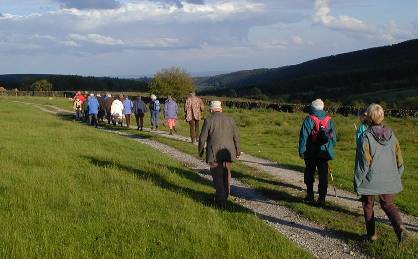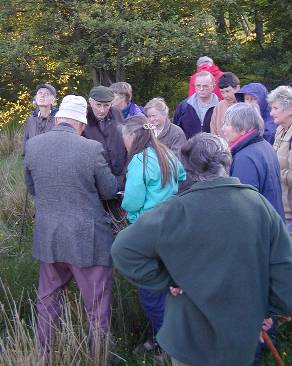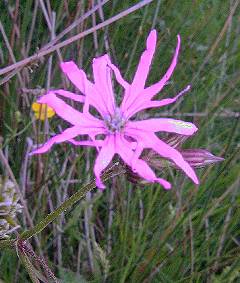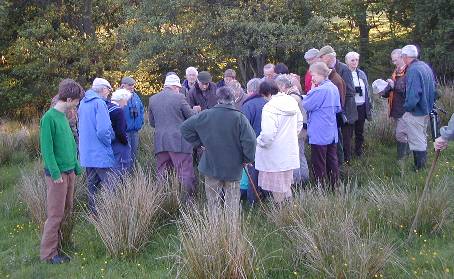
The party walking to the hayfield
Back to the Index page
[Species lists below]
There were about 30 people on this trip which was most encouraging. This was a joint expedition with the U3A and we were pleased to welcome many new faces. After meeting at Cow House Bank we were taken on a mystery tour through the forest and emerged out onto the moor just north of the escarpment. The main focus of the evening was an area of unimproved fields on the east-facing slopes above Bonfield Gill, consisting mostly of traditional hayfield species but with much wetter conditions on the lower-lying ground near the beck where there were a good number of interesting wetland species.

The party walking to the hayfield
We were lucky with the weather and the moors were looking particularly attractive in the clear evening light. However, we were less impressed by the voracious midges which emerged as the sun went down.
We only recorded a handful of bird species, many of them heard rather than seen (notably the curlews that were “bubbling” all around us). The highlight was the two woodcock roding as we walked back to the cars in the fading light.

We did rather better on the plants, recording over 80 species, most of them plants in flower. We were led by the wonderful double act of Don Buckle and Gordon Simpson who managed to identify everything with great expertise, even the half dozen or so sedges which to the untutored eye were all remarkably similar. Even more impressively, they showed the rest of us how to separate the different species, and made it all seem so much simpler than the books. (See the picture left, where Gordon is holding a masterclass in sedge identification.)

The upper part of the field was a hay meadow, with many of the characteristic species such as yellow rattle, pignut, lady’s mantle, milkmaids and various grasses, and also several common spotted orchids (left) and one or two heath spotted orchids.
 Indeed it was an interesting meadow because it seemed to have species one would normally associate with rather acidic conditions such as these heath spotted orchids growing close to lime-loving species such as quaking grass. I suspect that the soil was fairly neutral with mineral-rich seepages. Many of the flowers we saw were very tiny, growing in amongst the grasses – which led to a lot of stooping and bending down for a closer look (right).
Indeed it was an interesting meadow because it seemed to have species one would normally associate with rather acidic conditions such as these heath spotted orchids growing close to lime-loving species such as quaking grass. I suspect that the soil was fairly neutral with mineral-rich seepages. Many of the flowers we saw were very tiny, growing in amongst the grasses – which led to a lot of stooping and bending down for a closer look (right).
The lower parts of the fields were marshy, with rushes, sedges (8 different species overall plus the sedge-like Eleocharis quinqueflora and Blysmus compressus, the latter (Flat Sedge) ironically being much the most distinctive “sedge” we saw. As well as fragrant water mint (not yet in flower) and horsetails we saw interesting wetland species such as marsh valerian (past its best) and butterwort. This is an insectivorous plant whose rosette of yellowish-green leaves rather like a starfish act as natural flypaper, trapping insects which the plant uses to supplement its mineral intake. It usually grows in acid conditions among sphagnum mosses. It produces attractive violet-like flowers (left). It was also good to see ragged robin thriving; it used to be common everywhere in Ryedale wherever there was a damp corner, but so much farmland has been “improved” that it is now much less frequently seen. The specimens here were particularly fine (below).
It was also good to see ragged robin thriving; it used to be common everywhere in Ryedale wherever there was a damp corner, but so much farmland has been “improved” that it is now much less frequently seen. The specimens here were particularly fine (below).

This was a most enjoyable and informative evening and the RNHS is most grateful to Don Buckle and Gordon Simpson for leading the trip, and teaching us so much.
These lists are not exhaustive; I noted down the plants that I saw but may have missed some, especially grasses or species that were not in flower. The fact that even so there are 83 plants on the list shows how rich this area is. Thanks to Jim Pewtress for the bird list.
| English Name | Latin Name |
|---|---|
| Bedstraw, heath | Galium saxatile |
| Bedstraw, marsh | Galium palustre |
| Birch, silver | Betula verrucosa |
| Birdsfoot trefoil | Lotus corniculatus |
| Birdsfoot trefoil, marsh or greater (leaf) | Lotus pedunculatus |
| Bluebell | Hyacinthoides non-scripta |
| Bog Pimpernel (leaf) | Anagallis tenella |
| Bracken (fern) | Pteridium aquilinum |
| Bugle | Ajuga reptans |
| Buttercup, creeping | Ranunculus repens |
| Buttercup, meadow | Ranunculus acris |
| Butterwort | Pinguicula vulgaris |
| Catsear, common (leaf) | Hypochaeris radicata |
| Chickweed, common | Stellaria media |
| Clover, red | Trifolium pratense |
| Clover, white | Trifolium repens |
| Cowslip | Primula veris |
| Daisy | Bellis perennis |
| Daisy, dog or moon | Leucanthemum vulgare |
| Dock, broad-leaved | Rumex obtusifolius |
| Eyebright | Euphrasia officinalis agg. (probably E. nemorosa) |
| Forget-me-not, changing | Myosotis discolor |
| Foxglove (leaf) | Digitalis purpurea |
| Hay or Yellow Rattle | Rhinanthus cristo-galli |
| Hogweed (leaf) | Heracleum sphondylium |
| Horsetail, field or common | Equisetum arvense |
| Horsetail, marsh | Equisetum palustre |
| Knapweed, lesser (leaf) | Centaurea nigra |
| Lady’s Mantle | Alchemilla glabra |
| Lesser Spearwort (leaf) | Ranunculus flammula |
| Marsh pennywort | Hydrocotyle vulgaris |
| Marsh Thistle | Cirsium palustre |
| Mayweed (leaf, probably scentless) | Triplospermum maritimum |
| Milkmaid or Cuckoo-flower | Cardamine pratensis |
| Mint, water (leaf) | Mentha aquatica |
| Mouse-ear chickweed, common | Cerastium holosteoides (=C. fontanum) |
| Mouse-ear chickweed, sticky | Cerastium glomeratum |
| Nettle | Urtica dioica |
| Orchid, common spotted | Dactylorchis fuchsii |
| Orchid, heath spotted | Dactylorchis maculata |
| Pignut | Conopodium majus |
| Plantain, ratstail | Plantago major |
| Ragged Robin | Lychnis flos-cuculi |
| Rowan | Sorbus aucuparia |
| Rush, compact or clustered | Juncus conglomeratus |
| Rush, hard | Juncus inflexus |
| Rush, soft | Juncus effusus |
| Self Heal | Prunella vulgaris |
| Sorrel, common | Rumex acetosa |
| Speedwell, Germander | Veronica chamaedrys |
| Spike-rush, ? few-flowered | Eleocharis quinqueflora |
| Stitchwort, bog | Stellaria alsine |
| Stitchwort, lesser | Stellaria graminea |
| Sundew (?) | Drosera rotundifolia |
| Trefoil, yellow | Trifolium dubium |
| Valerian, marsh | Valeriana dioica |
| Vetch, tufted (leaf) | Vicia cracca |
| Wood sorrel (leaf) | Oxalis acetosella |
| Trees | |
| Alder | Alnus glutinosa |
| Bird Cherry (no flowers) | Prunus padus |
| Hawthorn | Crataegus monogyna |
| Holly | Ilex aquifolium |
| Sycamore | Acer pseudoplanatus |
| Grasses | |
| Crested Dogstail | Cynosurus cristatus |
| Meadow-grass, annual | Poa annua |
| Meadow-grass, smooth | Poa pratensis |
| Quaking Grass | Briza media |
| Red Fescue | Festuca rubra |
| Rye grass | Lolium perenne |
| Sheep’s Fescue | Festuca ovina |
| Soft Brome | Bromus mollis agg. |
| Sweet vernal Grass | Anthoxanthemum odoratum |
| Tufted Hairgrass | Deschampsia cespitosa |
| Yorkshire Fog | Holcus lanatus |
| Sedges | |
| Flat sedge | Blysmus compressus |
| Sedge, carnation | Carex panicea |
| Sedge, common or black | Carex nigra |
| Sedge, flea | Carex pulicaris |
| Sedge, glaucous | Carex flacca |
| Sedge, long-stalked yellow | Carex lepidocarpa |
| Sedge, oval | Carex ovalis |
| Sedge, pale | Carex pallescens |
| Sedge, star | Carex echinata |
Notes
I did not record the sundew myself. Also recorded were fungal infections similar to rust on nettle and (broad-leaved) dock, and some interesting galls. Gordon has identified these for us:
Birds
We only recorded 11 birds, but on the way back to the farm we saw and heard two woodcock roding (together, which is unusual; perhaps this was the boundary between two territories?)
Species recorded were: Curlew, Black-headed Gull, Woodpigeon, Meadow Pipit, Swallow, Robin, Wren, Blackbird, Rook, Woodcock and Chaffinch.
Other animals
Hedgehog and Common Frog.

Back to the Index page
© Ryedale Natural History Society 2002; Pictures © Adrian Smith 2002; Gill Smith (spotted orchid and butterwort)